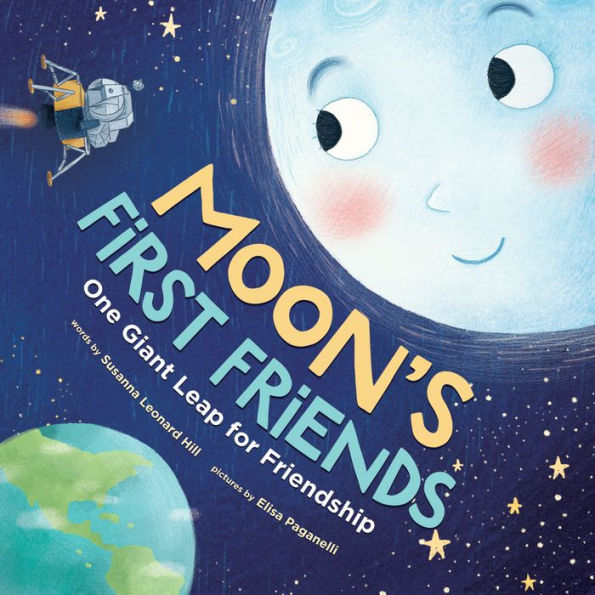The New York Times Book Review - Gillian Engberg
Susanna Leonard Hill's Moon's First Friends: One Giant Leap for Friendship sparks lunar interest with an age-old approach: Put a face on it. Forget the Man in the Moon (or the rabbit). This cheerful title introduces a rosy-cheeked, eye-lashed "Queen of the Night Sky"…Elisa Paganelli's textured digital artwork extends the winsome story with a cozy version of space…
From the Publisher
"This cheerful title introduces a rosy-cheeked, eye-lashed ‘Queen of the Night Sky,’ lonely after 4.5 billion years of silvery bright solitude. Elisa Paganelli’s textured digital artwork extends the winsome story with a cozy version of space, a soothing, star-speckled blue rather than bottomless black, and watched over by the eager, anthropomorphized "queen," who cheers as the Eagle lands right between her eyes." — The New York Times
"This is a story for young readers. It anthropomorphizes the moon, making her a character in the tale of the lunar landing. It's remarkably sweet, and kids ages 2 to 5 will love it." — Romper
"Set apart by its unusual point of view... Appended notes on the moon, NASA, spacesuits, and the Saturn V rocket also help to give the historic mission some background." — Kirkus Reviews
"In this playful book, the anthropomorphized moon watches humans from afar and eagerly notes as they invent the first airplane, build rockets and prepare to take the first tentative steps on her surface. Through text and informative back matter, young readers learn fascinating facts about the moon, astronauts and the space program." — Washington Parent
"For the littlest sky-watcher "The Moon’s First Friends" by Susanna Leonard Hill, illustrated by Elisa Paganelli, gives the orb a certain friendliness. Through the centuries, as this tale goes, the moon observed everything that happened on Earth, occasionally razzle-dazzling humans until finally, she had visitors! This is a cute story and, for curious 3-to-5-year-olds, there’s a nice afterword you can read, too." — Bookworm Sez
"A cute story [that] manages to deliver some facts (including how solar eclipses work!) seamlessly within the narrative." — Panetary.org
"In Paganelli’s friendly illustrations, the moon is an anthropomorphic, bright-eyed blue sphere with rosy cheeks who communicates with the changing world throughout history." — Publishers Weekly
Kirkus Reviews
2019-02-06
The Moon, lonely for so long, welcomes at last a pair of visitors from the planet below.
It's a long wait—dinosaurs come and go, and likewise woolly mammoths; the pyramids rise; the first balloons and gliders appear; a chimp in a Mercury capsule waves from orbit—but at long last two spacecraft stacked atop a huge multistage rocket make the journey: "They're actually coming!" The Moon, a light blue orb in Paganelli's pastel-toned scenes with big, lashed eyes and pink cheeks, watches in delight, warmly welcomes the two astronauts who land, and gives them gifts of rocks and dust (they in turn leave a plaque and a brightly colored flag) when it's time to go. "Come back anytime!" Hill neglects mention of the earlier and later Apollo visits but enhances her lunarcentric commemoration of Apollo 11 with a detailed if idiosyncratic account of that one and QR codes leading to actual sound clips of the countdown and Neil Armstrong's first remark. Appended notes on the moon, NASA, spacesuits, and the Saturn V rocket also help to give the historic mission some background.
One of a flurry of semicentennial tributes, set at least a bit apart by its unusual point of view. (Informational picture book. 5-7)




